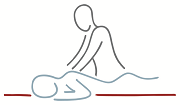Muscles work by shortening or “contracting”. They cannot lengthen by themselves. In this way our skeletal muscles can pull on our bones to enable movement. Muscles are “told” to contract by our brain, via our nerves. They contract when they receive an impulse from a motor nerve. These nerve impulses only stimulate a limited number of muscle fibres so that we can control the strength and extent of the muscle contraction. This bundle of fibres, served by a motor nerve is called a motor unit. Without these units, our nerves would stimulate the whole muscle and every move we made would be “all or nothing” to our muscles. This would make our movements jerky and exhausting.
A muscle can be strained when some or all of its’ fibres cannot cope with the demands being placed on them. This strain can occur in the muscle belly, where the tendon attaches to the bone or (most commonly) at the musculotendinous junction. Strains are more common in bi-axial muscles that span two joints e.g. Hamstrings, Quadriceps and Gastrocnemius. Muscles are most likely to strain during sudden acceleration or deceleration and strains are most common in sprinting, football and netball. Most strains are preventable and a number of factors can contribute to the damage. These include inadequate warm up, previous injury, excessive muscle tightness and overuse.
Strains can be classified in three grades or levels:
Grade 1 – A small number of muscle fibres are torn. There will be localised pain, but no loss of strength. Initial treatment should follow the P.R.I.C.E. protocol followed by soft tissue therapy, gentle stretching and remedial exercises to restore normal, pain-free function. Grade 1 strains take around 2 to 3 weeks to heal.
Grade 2 – A larger number of fibres are affected. There will be pain and swelling at the site of the strain and the pain will be reproduced upon muscle contraction. Muscle function will be reduced. Again, the P.R.I.C.E. protocol should be followed in the acute stage. In the sub-acute stage, soft tissue therapy, stretching and optimal loading will encourage the newly forming repair tissue to align itself with the normal stresses of the muscle and create a strong and healthy repair to the damaged fibres. A grade 2 strain can take 2 to 3 months to heal depending on the amount of fibres affected.
Grade 3 – A complete tear of the muscle. Most commonly seen at the musculotendinous junction (MTJ). There will be pain, swelling and bruising that should be treated with the P.R.I.C.E. protocol. Movement will be difficult due to these symptoms and the lack of muscle function. A grade 3 strain could require immobilisation of the affected area or even surgery to repair, but this is unlikely. It will take several months to heal with soft tissue therapy, rehabilitation exercises and careful stretching under medical supervision all essential to a healthy and strong repair.
If you need any advice about managing these common injuries, please get in touch.

